 |
 |
|
 |
 |
 |
 |
 |
|
 |
 |
 |
 |
Contact:
Diana Kenney, Marine Biological Laboratory
508-289-7139 or 508-289-7423; dkenney@mbl.edu
An Arctic with Fire
Wildfires are transforming the Alaskan tundra—and may be an accelerant to climate change
By Diana Kenney
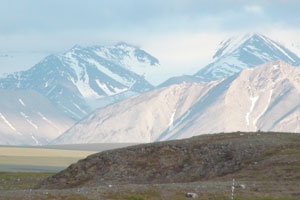
The Brooks Mountain range, which curves along the southern border of the North Slope region of Alaska. Credit: MBL Logan Science Journalism Program Full size image
|
 |
|
|
When it comes to weather, it’s hard to impress the Iñupiat people living at the northernmost tip of our nation. Frozen landscapes, cutting winds, and white-outs are normal in Barrow, Alaska, a small town on the Arctic Ocean about 1,300 miles from the North Pole. But two summers ago, even the oldest residents were startled by something new: flashes of light and powerful booms coming from the sky.
“These people had never seen a lightning storm at Barrow before,” says Gaius Shaver, an Arctic ecologist from the Marine Biological Laboratory’s Ecosystems Center in Woods Hole, Mass. “They didn’t know what to think.”
 |
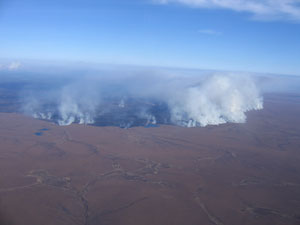
Sparked by lightning in mid-July of 2007, the Anaktuvuk River Fire burned more than 400 square miles before snow put it out in early October. Credit: Bureau of Land Management, Alaska Fire Service Full size image
|
|
|
With temperatures warming an average of 3 to 5 degrees over the past half-century, the climate on the North Slope of Alaska is in transition. Warmer air means more energy is available for thunderstorms where, once, it was just too cold. And more lightning is bringing another dramatic change to the tundra: Wildfires.
“The decade of the 2000s was, by far, the biggest for fires on the North Slope in half a century,” Shaver says. Thirteen wildfires torched nearly 260,000 acres over the decade—more than all the fires recorded and area burned on the North Slope since 1950. And as global warming continues, tundra wildfires are fully expected to increase, both in frequency and acreage burned.
The implications of fire in the Arctic—what Shaver calls “a new disturbance regime”—are profound. “Fire may be the trigger that shifts the North Slope landscape into a new state,” Shaver says—one vastly different from the frozen, treeless tundra of today. And it’s one that may feedback positively to global climate change.
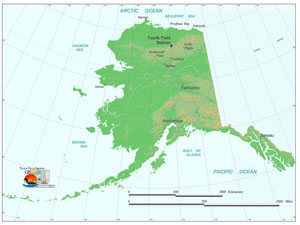
Alaska map courtesy of Toolik Field Station GIS Service. Full size image
|
 |
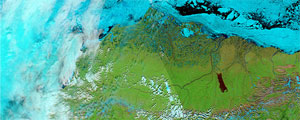
The Anaktuvuk River Fire is the dark shape in the right-center of this NASA-MODIS image of the North Slope of Alaska, acquired June 14, 2008. The burned area is bordered by the Nanushuk River on the west and the Itkillik River on the east. Credit: Courtesy of Jim Laundre, MBL Full size image
|
|
|
|
Shaver has been studying the Arctic tundra since the mid-1970s, and he knows how to look for gradual shifts in a landscape that is changing, but very slowly. Large disturbances such as fire—which leave the land open to rapid re-growth—have been rare. So when the biggest wildfire ever recorded on the North Slope blazed practically in Shaver’s backyard in 2007, he jumped into action. That was the Anaktuvuk River Fire, which scorched a 40-by-10 mile swath of tundra about 24 miles north of Toolik Field Station, where Shaver is the principal investigator of the NSF’s Artic Long-Term Ecological Research project.
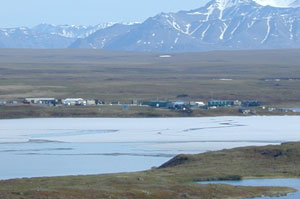
Toolik Field Station in the northern foothills of the Brooks Range, site of the NSF’s Arctic Long-Term Ecological Research (LTER) project. Credit: Courtesy of Jim Laundre, MBL Full size image
|
 |
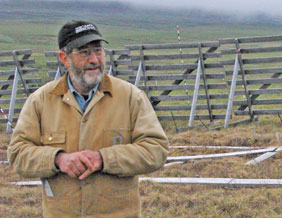
Gaius (Gus) Shaver, an ecologist from of the MBL Ecosystems Center, directs the NSF Arctic LTER. Credit: Jason Orfanon/MBL Logan Science Journalism Program Full size image
|
|
|
|
Shaver knew how critical it was to record the immediate impact of the fire—such as carbon and energy exchanges between the land and atmosphere. Locked in the permafrost, or frozen soil, of the northern latitudes is a huge reservoir of elements, including one-third of the globe’s total soil carbon. An Arctic regularly disturbed by fire could mean massive releases of CO2 into the atmosphere, pushing the ecosystem into a “new state of interacting with the global climate system,” Shaver says.

Charred earth at the site of the Anaktuvuk River Fire, June 2008. Credit: Jason Stuckey, Toolik Field Station Full size image
|
 |
|
|

MBL Ecosystems Center scientist Chris Neill inspects burned tussocks at the Anaktuvuk River fire site, July 2008. Credit: Jason Orfanon, MBL Logan Science Journalism Program Full size image
|
|
|
|
With NSF Small Grants for Exploratory Research funding later supplemented by NSF American Recovery and Reinvestment Act funds, Shaver quickly assembled a team of ecologists to analyze the fire’s impact on the soil, nearby streams, and atmosphere above the burn.
And, three years later, the scientists know the carbon loss was dramatic. The blaze itself released about 1.9 million metric tons of CO2, an amount that some small nations emit in a year. And even after one year of re-growth, the severely burned tundra continued to emit twice as much carbon as the unburned land. “That is a huge net loss of carbon to the atmosphere,” says Adrian Rocha of the Marine Biological Laboratory.
Moreover, the burn, because it is darker, absorbs more solar radiation than undisturbed land. “You have much higher rates of permafrost thawing, and depth of thaw, on the burn,” Shaver says.
All of these immediate consequences of the fire reinforce the effects of a warming climate on the Arctic tundra. And the scientists don’t yet know if the land can recover the carbon and energy balance of its pre-burn state, or if they are looking at a “new normal,” Shaver says.
Another significant question hangs in the air. Will fire nudge a major transformation of the North Slope groundcover that is already slowly underway?
“Satellites tell us there has clearly been a greening of the Arctic over the past 30 years,” Shaver says. Many observations point to a warmer landscape that will be dominated by shrubs, rather than the grasses and mosses of today. Some scientists forecast that large parts of the Arctic tundra will eventually become forest.
“A key question is whether the conditions on these burn sites are more favorable for the establishment of new seeds, new species,” Shaver says. He and Rocha are keeping a close eye on the tiny sprouts that are pushing up from the blackened land, and within a few years will know whether a change in species composition has emerged from the burn.
“This is very exciting to me,” Shaver says. “If we have more fires in the Arctic, are we moving to a regional system in which the most important changes are occurring in small patches of highly disturbed land, while the rest of the landscape is changing very slowly? If that happens, it is another way of the ecosystem moving to a new state.”
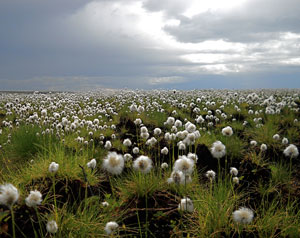
A bloom of cottongrass (Eriophorum vaginatum) spreads over the Anaktuvuk burn site, July 2009. The fire stimulated an anomalous flowering of the grass, which was the predominant vegetation before the fire. Credit: MBL Logan Science Journalism Program Full size image
|
 |
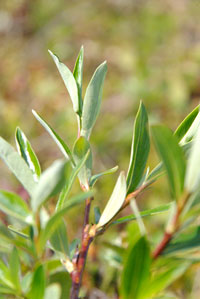
More shrubs, such as willow (Salix species) are expected to appear in the Arctic landscape as the climate warms, a trend that may be accelerated by the advent of fires. Credit: Chris Neill, MBL Full size image
|
|
|
|
|
| |
|
|
 |
 |
|